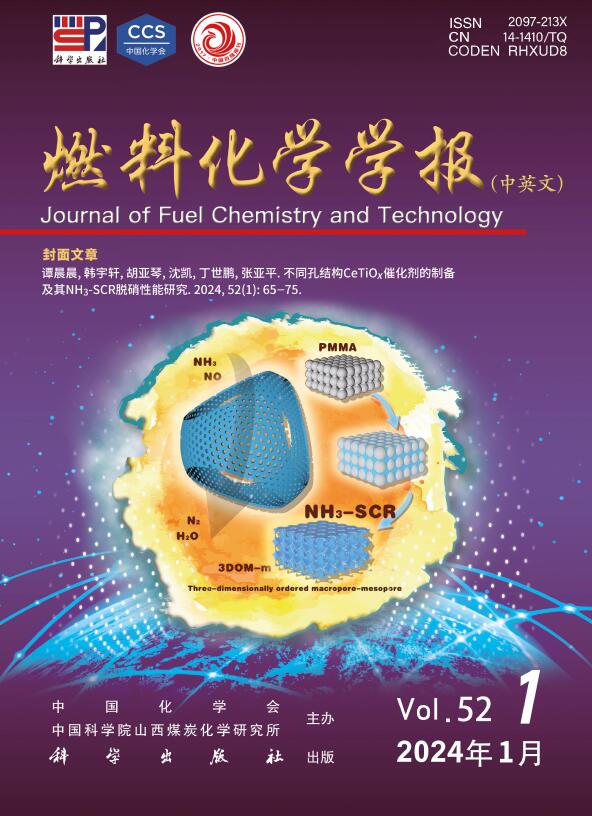Preparation of Sm-doped Cu-Ce high sulphur-resistant CO oxidation catalysts by combustion co-precipitation method
Q3 Energy
引用次数: 0
Abstract
Cu-Ce catalysts have been extensively studied owing to their excellent low-temperature CO oxidation activity. However, they are prone to deactivation in the presence of both water vapor and sulfur. In this study, Ce-Cu-Sm CO oxidation catalysts with enhanced sulfur resistance were synthesized by Sm doping using three methods: combustion, co-precipitation, and acid solution synergistic co-precipitation. The mechanism underlying the improved sulfur resistance was investigated using XRD, TEM, N₂ adsorption and desorption, XPS, H2-TPR, and CO-TPD techniques. The results revealed that, under the coexistence of 1% CO, 10% H2O, and 0.01% SO2, the 20Ce-5Cu-4Sm-CG catalyst (prepared via acid solution synergistic co-precipitation) maintained a 100% CO oxidation efficiency for 220 min at 220 °C and a space velocity of 60000 mL/(g·h). After 280 min, the performance of the 20Ce-5Cu-4Sm-CG catalyst decreased to 70%, which was 1.3 times and 2.5 times higher than that of the 20Ce-5Cu-4Sm-C and 20Ce-5Cu-C catalysts prepared by the co-precipitation method, respectively. Characterization analysis revealed that Sm doping increased the CeO2 crystal size to a certain extent and reduced the specific surface area of the catalyst. However, it also enhanced the concentrations of Ce3+, Cu⁺, and surface oxygen atoms, as well as the ratio of Oα and the number of oxygen vacancies in the CeO2 lattice, which collectively improved the ability of the catalyst to oxidize CO under sulfur-containing atmosphere. The acid solution combustion synergistic co-precipitation method not only enhanced these five key properties for CO oxidation mentioned above, but also facilitated the formation of coordination complexes with the acid solution and Sm ions during combustion. These complexes were incorporated into the CeO2 lattice to form a homogeneous solid solution, which made the catalyst particle size more uniform and the specific surface area larger, and eliminated the adverse effects of Sm doping on the surface structure. As a result, the oxidation ability of the catalyst was further improved. In summary, the 20Ce-5Cu-4Sm catalyst, prepared via the acid solution combustion and co-precipitation method, exhibits excellent sulfur resistance and enhances the performance of non-precious metal oxide CO oxidation catalysts for applications in sulfur-containing environments.
燃烧共沉淀法制备sm掺杂Cu-Ce高抗硫CO氧化催化剂
Cu-Ce催化剂由于具有优异的低温CO氧化活性而得到了广泛的研究。然而,它们在水蒸气和硫的存在下容易失活。本研究采用燃烧、共沉淀法和酸溶液协同共沉淀法,通过Sm掺杂制备了Ce-Cu-Sm CO抗硫氧化催化剂。采用XRD、TEM、N₂吸附与解吸、XPS、H2-TPR、CO-TPD等技术研究了其抗硫性能提高的机理。结果表明,在1% CO、10% H2O和0.01% SO2共存的条件下,酸液协同共沉淀法制备的20Ce-5Cu-4Sm-CG催化剂在220℃、60000 mL/(g·h)空速下可保持100%的CO氧化效率220 min。280min后,20Ce-5Cu-4Sm-CG催化剂的性能下降到70%,分别是共沉淀法制备的20Ce-5Cu-4Sm-C和20Ce-5Cu-C催化剂的1.3倍和2.5倍。表征分析表明,Sm掺杂在一定程度上增加了CeO2晶粒尺寸,降低了催化剂的比表面积。然而,它也提高了Ce3+、Cu +和表面氧原子的浓度,以及CeO2晶格中Oα的比值和氧空位的数量,这些共同提高了催化剂在含硫气氛下氧化CO的能力。酸溶液燃烧协同共沉淀法不仅提高了CO氧化的这五个关键性能,而且在燃烧过程中促进了酸溶液和Sm离子的配位配合物的形成。这些配合物被并入CeO2晶格中形成均匀的固溶体,使催化剂粒径更均匀,比表面积更大,消除了Sm掺杂对表面结构的不利影响。从而进一步提高了催化剂的氧化能力。综上所述,通过酸溶液燃烧和共沉淀法制备的20Ce-5Cu-4Sm催化剂具有优异的抗硫性能,提高了非贵金属氧化物CO氧化催化剂在含硫环境中的应用性能。
本文章由计算机程序翻译,如有差异,请以英文原文为准。
求助全文
约1分钟内获得全文
求助全文
来源期刊

燃料化学学报
Chemical Engineering-Chemical Engineering (all)
CiteScore
2.80
自引率
0.00%
发文量
5825
期刊介绍:
Journal of Fuel Chemistry and Technology (Ranliao Huaxue Xuebao) is a Chinese Academy of Sciences(CAS) journal started in 1956, sponsored by the Chinese Chemical Society and the Institute of Coal Chemistry, Chinese Academy of Sciences(CAS). The journal is published bimonthly by Science Press in China and widely distributed in about 20 countries. Journal of Fuel Chemistry and Technology publishes reports of both basic and applied research in the chemistry and chemical engineering of many energy sources, including that involved in the nature, processing and utilization of coal, petroleum, oil shale, natural gas, biomass and synfuels, as well as related subjects of increasing interest such as C1 chemistry, pollutions control and new catalytic materials. Types of publications include original research articles, short communications, research notes and reviews. Both domestic and international contributors are welcome. Manuscripts written in Chinese or English will be accepted. Additional English titles, abstracts and key words should be included in Chinese manuscripts. All manuscripts are subject to critical review by the editorial committee, which is composed of about 10 foreign and 50 Chinese experts in fuel science. Journal of Fuel Chemistry and Technology has been a source of primary research work in fuel chemistry as a Chinese core scientific periodical.
 求助内容:
求助内容: 应助结果提醒方式:
应助结果提醒方式:


